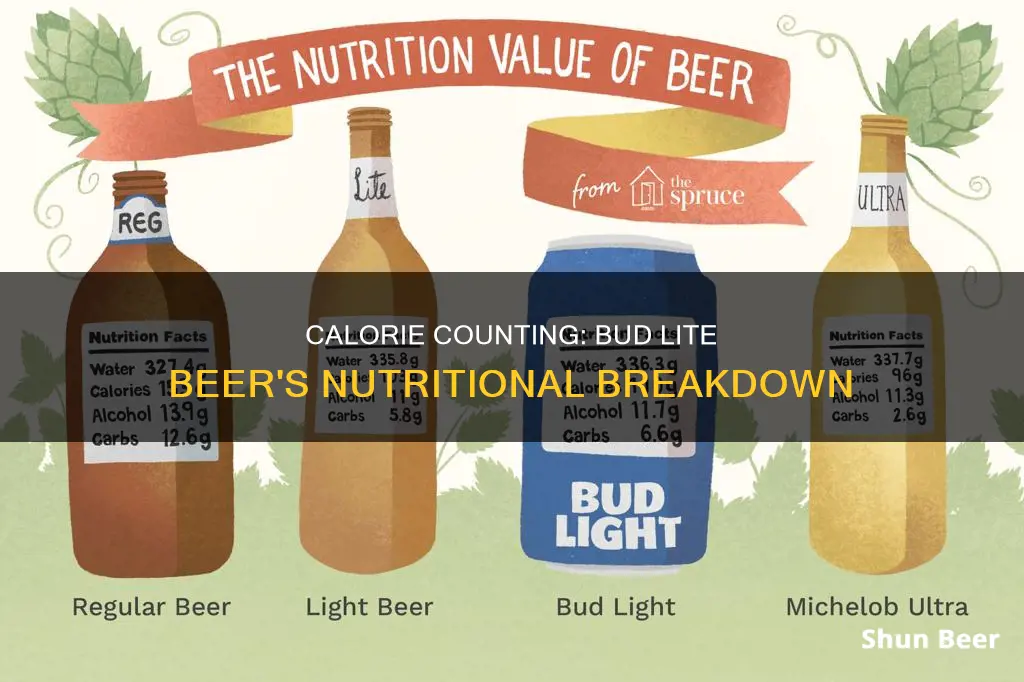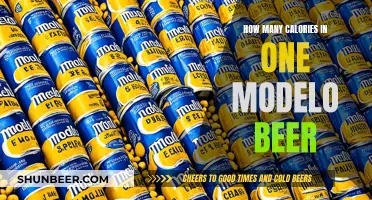
Beer is a popular alcoholic beverage with a dedicated fan following. While it is enjoyed by many, some beer enthusiasts are curious about its nutritional value and, more specifically, its calorie content. Bud Light, a well-known beer brand, has addressed this concern by introducing nutrition labels on its packaging. Bud Light contains 110 calories per 12-ounce can or bottle, with variations like Bud Light Next claiming to have only 80 calories. With its large-format label, Bud Light is leading the way in providing transparent nutritional information to its consumers.
What You'll Learn
- Bud Light contains 110 calories per 12-ounce can or bottle
- Alcohol brands aren't required to disclose nutrition facts, but Bud Light does so voluntarily
- Bud Light's calories mainly come from alcohol, with minimal flavour calories
- Bud Light has fewer calories than Budweiser, which has 145 calories per 12-ounce serving
- Bud Light Next is a low-calorie variant with 80 calories and 4% alcohol

Bud Light contains 110 calories per 12-ounce can or bottle
When it comes to beer,section it's important to remember that calorie counts can vary depending on the specific brand and type. In the case of Bud Light, a 12-ounce can or bottle contains 110 calories. This calorie count is lower than some other popular beers, such as Budweiser, which has 145 calories in a 12-ounce serving.
The number of calories in a beer can be influenced by various factors, including the alcohol content and the presence of carbohydrates and proteins. In the case of Bud Light, the lower alcohol content contributes to its slightly lower calorie count when compared to other beers. Additionally, Bud Light contains 6.6 grams of carbohydrates and 0.9 grams of protein per 12-ounce serving.
It's worth noting that while Bud Light may have fewer calories than some other beers, it doesn't necessarily mean it's a "light" or "low-calorie" beverage. The term "light beer" typically refers to a reduced level of alcohol, and the lower calorie count is a byproduct of this reduction. However, compared to other beers, Bud Light's alcohol content by volume is still relatively standard, at 4.2%.
Additionally, it's important to remember that alcohol brands are not required to disclose nutrition facts. However, in recent years, there has been a push for more transparency, with major beer brands voluntarily agreeing to disclose nutritional information on their labels. This trend towards transparency can help consumers make more informed choices about their beverage options.
In summary, Bud Light contains 110 calories per 12-ounce can or bottle, which is slightly lower than some other popular beers. This calorie count is influenced by the alcohol content and the amount of carbohydrates and proteins present. While Bud Light may not be considered a "light" beer in terms ofsection flavour or colour, it does offer a slightly lower-calorie option within the beer category.
Calories in Amber Bach Beer: Nutritional Facts Explored
You may want to see also

Alcohol brands aren't required to disclose nutrition facts, but Bud Light does so voluntarily
Alcoholic beverages are not required to disclose nutrition facts, but some brands, like Bud Light, choose to do so voluntarily. This is because alcoholic products are regulated by the Alcohol and Tobacco Tax and Trade Bureau (TTB), rather than the Food and Drug Administration (FDA), which mandates nutritional labelling for packaged food and beverages.
The separation of regulatory organisations dates back to the 1930s, when, after the repeal of Prohibition, the government established an entity to oversee the regulation of now-legal beverages, separate from the FDA. This entity eventually evolved into the TTB.
In 2013, the TTB made nutrition labels optional for alcoholic beverages, but not mandatory. This was the result of pressure from consumer advocacy groups, who had been pushing for labelling for years. However, alcohol manufacturers had successfully resisted these efforts, arguing that putting nutrition facts on bottles would make consumers think that alcohol was nutritious.
Despite the optional nature of labelling, Bud Light has chosen to include serving facts on its packaging. This allows the brand to showcase that a single bottle contains only 110 calories, which is lower than some other beers, such as Budweiser, which has 145 calories. By including this information, Bud Light can appeal to calorie-conscious consumers. Additionally, the inclusion of ingredients makes the brand seem more transparent, especially given the controversy around the use of corn syrup in beer production.
Bud Light is not the only brand to voluntarily include nutrition facts. Other major breweries, including those under AB InBev, MillerCoors, Heineken USA, and more, have also planned to publish serving facts and other information on their packaging.
Calorie Count of Alaskan Amber Beer Explained
You may want to see also

Bud Light's calories mainly come from alcohol, with minimal flavour calories
A standard 12-ounce serving of Bud Light contains 110 calories. This is towards the lower end of the calorie range for the top 10 most popular beers in the United States, which ranges from around 95 to just under 150 calories.
Bud Light is a "light beer", which by industry definition means it has a reduced level of alcohol. This reduction in alcohol content is what primarily reduces the calorie count. Alcohol has 7 calories per gram, and Bud Light's calories mainly come from alcohol, with minimal flavour calories.
In 2019, Bud Light became the first major beer brand to debut a large-format label showing the beer's ingredients, calories, and nutrition information. This was after major beer brands agreed to voluntarily disclose nutritional information on their labels by 2020.
Bud Light Next, a 4% ABV variety, claims to contain just 80 calories per 12oz can. This has been the subject of some debate, with some people questioning how it is possible for a 4% beer to contain so few calories. However, this is largely due to the low number of flavour calories, with the majority of calories coming from alcohol.
Calorie Counting: Sopora Beer's Nutritional Breakdown
You may want to see also

Bud Light has fewer calories than Budweiser, which has 145 calories per 12-ounce serving
When it comes to calorie content, Bud Light and Budweiser are quite different. Bud Light has fewer calories than Budweiser, which has 145 calories per 12-ounce serving. This difference is due to Bud Light's reduced alcohol content, which is a common characteristic of light beers. In fact, Bud Light contains only 110 calories per 12-ounce can or bottle, making it a slightly lower-calorie option.
While Bud Light may be a better choice for those counting calories, it's important to understand that "light" in the context of beer typically refers to a lower alcohol content rather than a reduced number of calories. The lower calorie count is simply a byproduct of the decreased alcohol content. However, it's worth noting that alcohol brands, including Bud Light, are not required to disclose nutrition facts. Nonetheless, in 2016, major beer brands voluntarily agreed to provide this information on their labels by 2020.
Bud Light's decision to debut a new large-format label showcasing its ingredients, calories, and nutrition information is a step towards transparency and empowering consumers to make informed choices. This move sets a precedent for other beer brands and allows consumers to easily access nutritional information.
Comparing Bud Light to other beers in the market, such as Skinny Lager, provides additional context. Despite having a lower alcohol content, Bud Light's calorie count is slightly lower than Skinny Lager's. However, customer feedback suggests that there is a demand for a low-calorie beer that doesn't compromise on flavour and strength, which Skinny Lager seems to fulfil better.
In summary, Bud Light offers a lower-calorie alternative to Budweiser, with 110 calories per 12-ounce serving compared to Budweiser's 145 calories. This difference is primarily due to Bud Light's reduced alcohol content, and it positions the beverage as a more calorie-conscious option for consumers.
Calorie Counting: Amstel Beer's Nutritional Breakdown
You may want to see also

Bud Light Next is a low-calorie variant with 80 calories and 4% alcohol
Bud Light is a popular beer in the United States, often enjoyed by fraternity members and sports enthusiasts. While the exact calorie count of Bud Light is not always clear, it is generally agreed that a 12-ounce can or bottle contains 110 calories. This is in line with other popular beers in the US, which range from 95 to 150 calories per 12-ounce serving. Bud Light's main competitor, Budweiser, contains 145 calories per 12-ounce serving.
In 2019, Bud Light began displaying its nutritional information on its packaging, including calories, ingredients, and other nutritional facts. This was a voluntary decision, as alcohol brands are not required to disclose this information.
However, Bud Light also offers a low-calorie variant called Bud Light Next, which contains just 80 calories per 12-ounce can. This beer also has an alcohol content of 4%, which is slightly lower than the standard Bud Light, which has an ABV of 4.2%. Bud Light Next is an impressive example of an ultra-low-calorie beer, with most of its calories derived from alcohol.
The creation of Bud Light Next is a response to consumer demand for a low-calorie beer that doesn't compromise on taste. While some low-calorie beers can be overly watery or lack flavour, Bud Light Next aims to provide a more satisfying drinking experience. The beer is targeted at health-conscious consumers who want to enjoy a beer without the usual calorie count. It is also ideal for those following a low-carb diet, as it contains zero carbs.
The low-calorie count of Bud Light Next is achieved through efficient brewing techniques that convert sugars into alcohol during fermentation. This results in a beer where the majority of the calories come from alcohol, with only a small number of "flavour" calories. Hops, which add flavour to beer, do not contribute significantly to the calorie count.
Yueng Beer's Calorie Count: How Does It Compare?
You may want to see also
Frequently asked questions
A 12-ounce can or bottle of Bud Light beer contains 110 calories.
Bud Light's calorie count is on the lower end compared to other popular beers in the United States, which range from around 95 to just under 150 calories.
Bud Light Next, which has 4% alcohol, is claimed to have 80 calories per 12-ounce can.
A 200-calorie serving of Bud Light refers to a larger quantity of 690 grams, which is not the standard serving size.







